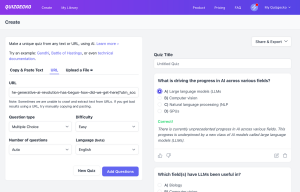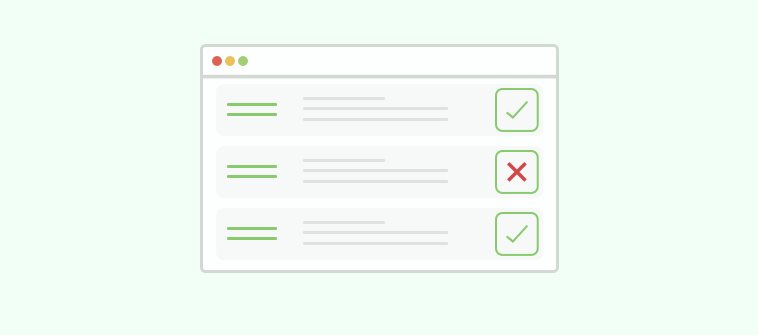Remember feeling dreadful while facing a mountain of exams during your school days?
As someone who’s always been fascinated by learning, I realized there had to be a better way to gauge student progress, and perhaps, assessment tools in teaching are the need of the hour.
These go far beyond traditional tests, offering a rich tapestry of methods to understand how your students learn and what resonates with them.
So, here I have brought a detailed guide to assessment tools in teaching, including why they are important, their types, and the popular assessment software for teaching.
Before that, here’s a quick video for you to learn how to create an assessment online:
What Are Assessment Tools in Teaching?
Assessment tools are instruments used to evaluate students’ knowledge, skills, and progress in teaching. They provide critical insights into student learning, enabling educators to tailor instruction effectively.
These tools can help teachers identify areas where students need improvement and even evaluate student learning at the end of an instructional period.
For instance, studies show that students who receive regular feedback improve their performance by up to 30%.
In fact, research indicates that diverse assessment methods can better address different learning styles and needs, contributing to more equitable education. Effective assessment tools foster an engaging learning environment, guiding both teaching strategies and student learning patterns.
Also Read: Top 7 Digital Assessment Tools for Teachers in 2024: Shaping Future Education
Why Are Assessment Tools Important in Teaching?
| “The teacher who assesses his students by providing feedback is like the optician who gives the people suitable glasses to see better and clear.” ― Fatima Almomen |
After checking assessment tools, it’s crucial to understand the importance of assessment tools in teaching. Here are some of the major reasons:
1. Measuring Student Learning Outcomes:
- Objective Evaluation: They objectively measure how well students understand the material.
- Progress Tracking: Teachers can track student progress over time and identify areas where students excel or struggle.
2. Informing Instructional Practices Effectively:
- Feedback for Teachers: Assessment tools offer feedback that can inform instructional practices and help teachers adjust their teaching strategies to meet the needs of their students.
- Differentiated Instruction: They enable teachers to identify individual student needs and tailor their instruction accordingly.
3. Motivating Students Through Goal Setting:
- Goal Setting: Assessments can help students set goals and motivate them to achieve specific learning outcomes.
- Self-assessment: They encourage students to reflect on their own learning and take responsibility for their educational progress.
4. Ensuring Accountability in Education:
- Standards Alignment: Assessment tools ensure that teaching aligns with educational standards and learning objectives.
- School Improvement: They provide data that can be used for school-wide improvement initiatives and to demonstrate accountability to stakeholders.
5. Providing Constructive Feedback Regularly:
- Constructive Feedback: Students receive constructive feedback that helps them understand their strengths and areas for improvement.
- Continuous Improvement: Ongoing educational assessments foster a culture of continuous improvement and learning.
6. Identifying Learning Gaps Early On:
- Early Intervention: Assessment tools help identify learning gaps early, allowing for timely intervention and support.
- Personalized Learning: They facilitate personalized learning plans to address specific needs and learning styles.
7. Supporting Curriculum Development Processes:
- Curriculum Evaluation: Assessment data can be used to evaluate the effectiveness of the curriculum and make necessary adjustments.
- Resource Allocation: It helps in making informed decisions about resource allocation and professional development needs.
8. Enhancing Communication With Stakeholders:
- Parent-Teacher Communication: Assessments provide a basis for meaningful communication between teachers and parents about student progress and areas needing attention.
- Student-Teacher Interaction: They foster better student-teacher interaction by clarifying expectations and learning objectives.
So, assessment tools are important in the educational process as they support a data-driven approach to teaching and learning, ensuring that all students have the opportunity to succeed.
Watch This Case Study: How University of Zurich Streamlined Assessments & Reduced Workload | ProProfs Case Study
What Are the Different Types of Assessments in Teaching?
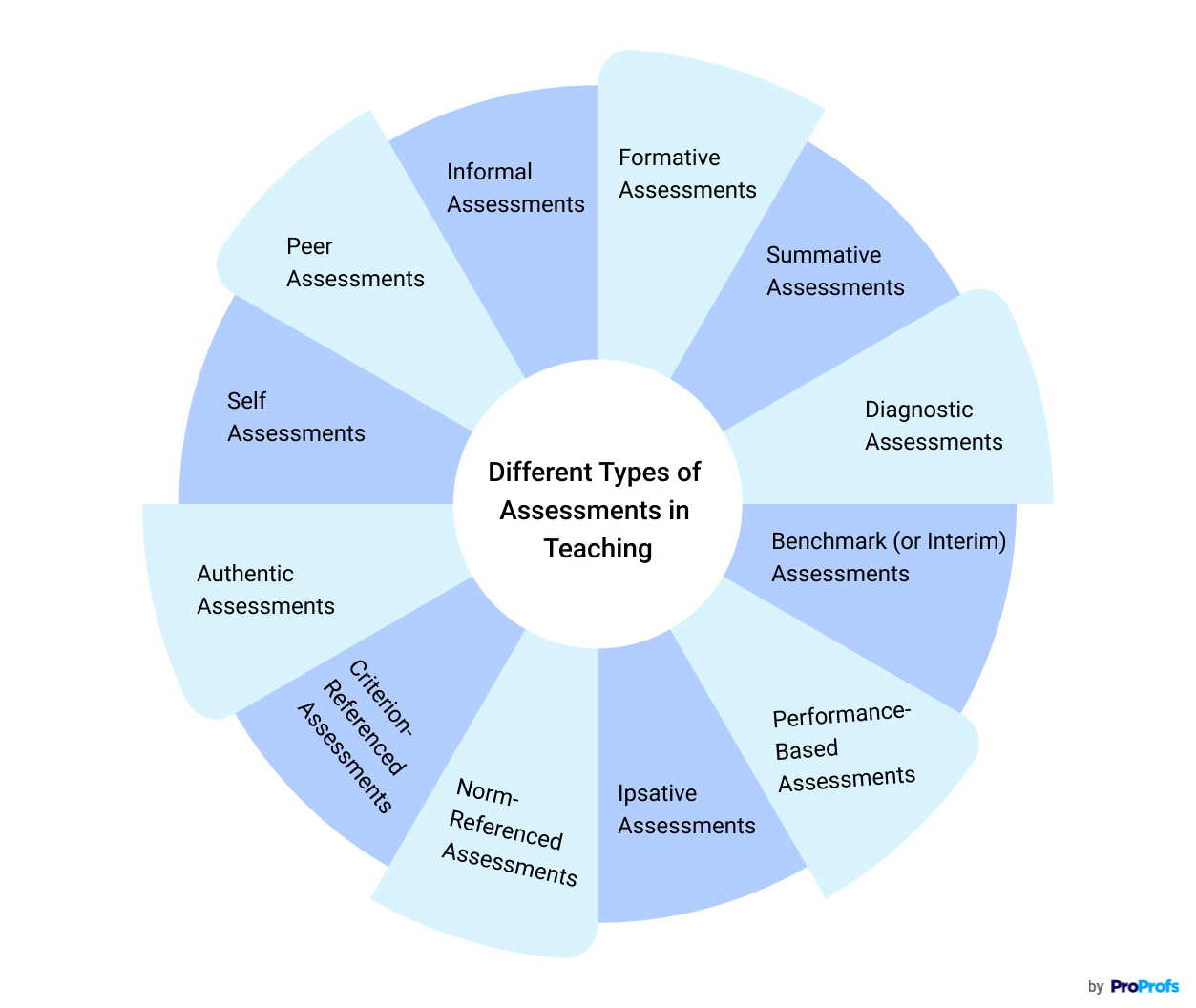
Before we get to know the different types of assessment tools in teaching, here are the different types of assessments commonly used in education:
- Formative Assessments
They monitor student learning and provide ongoing feedback that can be used by instructors to improve their teaching and by students to improve their learning. These assessments help identify students’ strengths and weaknesses and target areas that need more attention.
Examples: Quizzes, classroom discussions, homework assignments, observation, peer assessments, and exit tickets.
Read More: What is Formative Assessment? Types, Examples & Strategies
- Summative Assessments
They help evaluate student learning, skill acquisition, and academic achievement at the conclusion of a defined instructional period, such as a unit, course, or school year. They provide a comprehensive overview of what students have learned and help determine whether the educational goals and standards have been met.
Examples: Final exams, end-of-term projects, standardized tests, and final papers.
Read More: What Is Summative Assessment? (+Types, Examples, Benefits & Strategies)
- Diagnostic Assessments
These are meant to identify students’ existing knowledge base, skills, and learning needs before instruction begins. They help teachers understand where each student stands in terms of prior knowledge and design instruction that builds on current understanding and skills of students.
Examples: Pre-tests, skill inventories, and initial writing prompts.
Read More: Guide to Diagnostic Assessments in Education: Definition, Types & Examples
- Benchmark (or Interim) Assessments
They help to measure student progress at regular intervals throughout the academic year. These assessments provide timely information on whether students are on track to meet end-of-year learning goals.
Examples: Quarterly tests, mid-term exams, and periodic standardized assessments.
- Performance-Based Assessments
You can use them to evaluate students’ ability to apply their skills and knowledge to real-world tasks and challenges. These assessments go beyond traditional testing by requiring students to demonstrate their learning through practical application. Performance-based assessments encourage critical thinking, problem-solving, and creativity, providing a more comprehensive view of student capabilities and readiness for real-life situations.
Examples: Science experiments, oral presentations, portfolios, and research projects.
Read More: What Is a Performance Assessment? (Meaning, Types & Examples)
- Ipsative Assessments
These assessments measure a student’s current performance against their previous performances. They focus on personal improvement and growth over time rather than comparing students to a standard or to each other. They also promote self-awareness and self-motivation, encouraging students to set personal goals and strive for continuous improvement in their learning journey.
Examples: Personal progress reports, self-reflection essays, and growth tracking.
- Norm-Referenced Assessments
They compare a student’s performance against a national or other norm group. These assessments determine how well a student performs relative to their peers. They can also be used to rank students, identify high and low performers, and make decisions about placement in programs or interventions.
Examples: SAT, ACT, and other standardized tests where scores are compared to a norm group.
- Criterion-Referenced Assessments
You can use them to measure a student’s performance against a specific set of criteria or learning standards. These educational assessments determine whether a student has achieved particular skills or knowledge as defined by predetermined criteria. Criterion-referenced assessments focus on mastery of content, providing clear information about what students know and can do.
Examples: State assessments based on curriculum standards and proficiency tests.
- Authentic Assessments
These are used to assess students’ abilities in a real-world context. They require students to apply their learning to practical, meaningful tasks that reflect the complexities of real life. They often involve tasks such as problem-solving, project-based learning, and simulations that mirror professional and everyday situations.
Examples: Student portfolios, project-based learning assessments, and simulations.
- Self-Assessments
Self-assessments allow students to evaluate their own learning and progress. They encourage students to reflect on their strengths, weaknesses, and areas for improvement. They foster metacognitive skills, promoting self-regulation and independent learning.
Examples: Self-rating scales, reflective journals, and self-evaluation checklists.
- Peer Assessments
These assessments involve students in evaluating each other’s work and provide opportunities for collaborative learning and feedback, allowing them to learn from their peers. Peer assessments enhance critical thinking and communication skills, as students engage in evaluating and providing constructive feedback. They also promote a sense of community and shared responsibility for learning within the classroom.
Examples: Peer reviews of assignments, group project evaluations, and peer feedback forms.
- Informal Assessments
Informal Assessments help you to gather information about student learning in a less structured and more spontaneous way. These assessments provide immediate insights into student understanding and progress. They help teachers to make quick adjustments to their teaching strategies and to address any learning gaps or misconceptions as they arise.
Examples: Teacher observations, ungraded quizzes, and spontaneous oral questions.
Read More: 13 Different Types of Assessments You Should Know About
List of the Best Assessment Tools & Software for Teaching
Here is a list of some of the most popular assessment tools and software options available for teaching purposes. Let’s review each with their pros and cons to get a better idea.
1. ProProfs Quiz Maker
Easily Creating Secure Quizzes & Assessments With AI or Templates
I’ve found ProProfs Quiz Maker to be a wonderful tool in teaching, particularly for creating quizzes and assessments. It has an AI quiz generator that helps you generate all kinds of quizzes in just a few seconds. Plus, you get an extensive library of 100+ customizable assessment templates that streamline the quiz creation process, making it both efficient and effective.
What sets ProProfs apart is its robust security features, ensuring the integrity and confidentiality of the assessments. Whether I am designing a quick quiz or a detailed evaluation, ProProfs offers a user-friendly interface that makes customization a breeze.
I also like its automatic grading and scoring support, which allows you to offer instant feedback to the candidates and ensures an engaging assessment process.
What You Will Like:
- It supports multimedia integration, including images, videos, and audio in quizzes, making them more engaging and interactive.
- The tool provides detailed analytics and reporting to track student performance over time, helping educators identify areas where students need improvement.
- The platform supports 15+ interactive question types, including multiple-choice, multimedia questions, hotspot, and essay questions, catering to various assessment needs.
- It offers seamless integration with LMSs, including Blackboard and Canvas, ensuring that it fits smoothly into existing educational workflows.
- It supports both scored and personality quizzes, allowing you to evaluate candidates in various aspects.
- You can award custom certificates to the assessment takers according to their performance.
- It allows you to set up an online classroom for learning assessment and let learners access quizzes from a central location.
What You May Not Like:
- The free version supports only short quizzes. It can support a few more questions.
- It does not support a dark mode on the website.
Pricing: Forever FREE for short quizzes and all essential features. Paid starts at $19.99/month.
2. Google Forms
Best for Creating Free Forms, Basic Quizzes, & Surveys
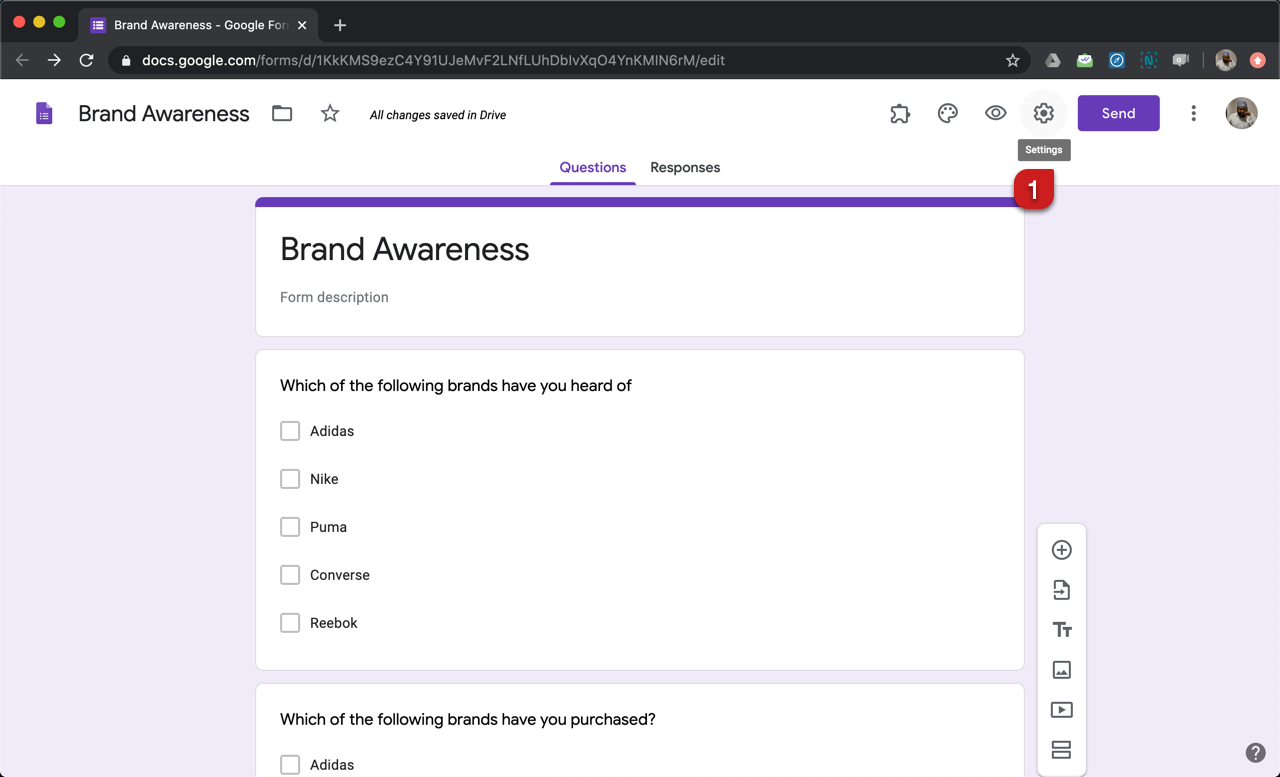
(Image Source: Formfacade)
Google Forms is one of the best assessment tools for teachers, which helps in creating free forms, basic quizzes, and surveys with minimal hassle. The simplicity of the tool is unmatched, allowing me to set up assessments and share them with students effortlessly and quickly.
The real-time response tracking and automatic data collection are invaluable for instant feedback and analysis. Integrated seamlessly with Google Workspace, it enhances collaboration and productivity.
The tool is ideal for educators seeking a straightforward, cost-effective solution for basic assessments that do not require advanced features but still offer reliability and ease of use.
What You Will Like:
- Google Forms is free to use with any Google account, making it an accessible option for educators with limited budgets.
- The platform supports various question types, including text, multiple-choice, and dropdown, providing flexibility in designing assessments.
- It provides real-time collaboration, allowing multiple users to edit forms simultaneously, which is useful for team projects and co-teaching scenarios.
- Google Forms includes automatic data collection and visualization in Google Sheets, simplifying the process of analyzing responses.
- Responses can be collected via email, links, or embedded forms, offering multiple ways to reach students and gather data.
What You May Not Like:
- It lacks advanced analytics and reporting features, which can be a drawback for educators needing in-depth data analysis.
- The platform does not support multimedia integration in questions, limiting the types of content that can be included.
Pricing: Starts at $12/month/user. Billed annually.
Related Read: 6 Best Google Forms Alternatives in 2024
3. Kahoot
Best for Gamified Quizzes
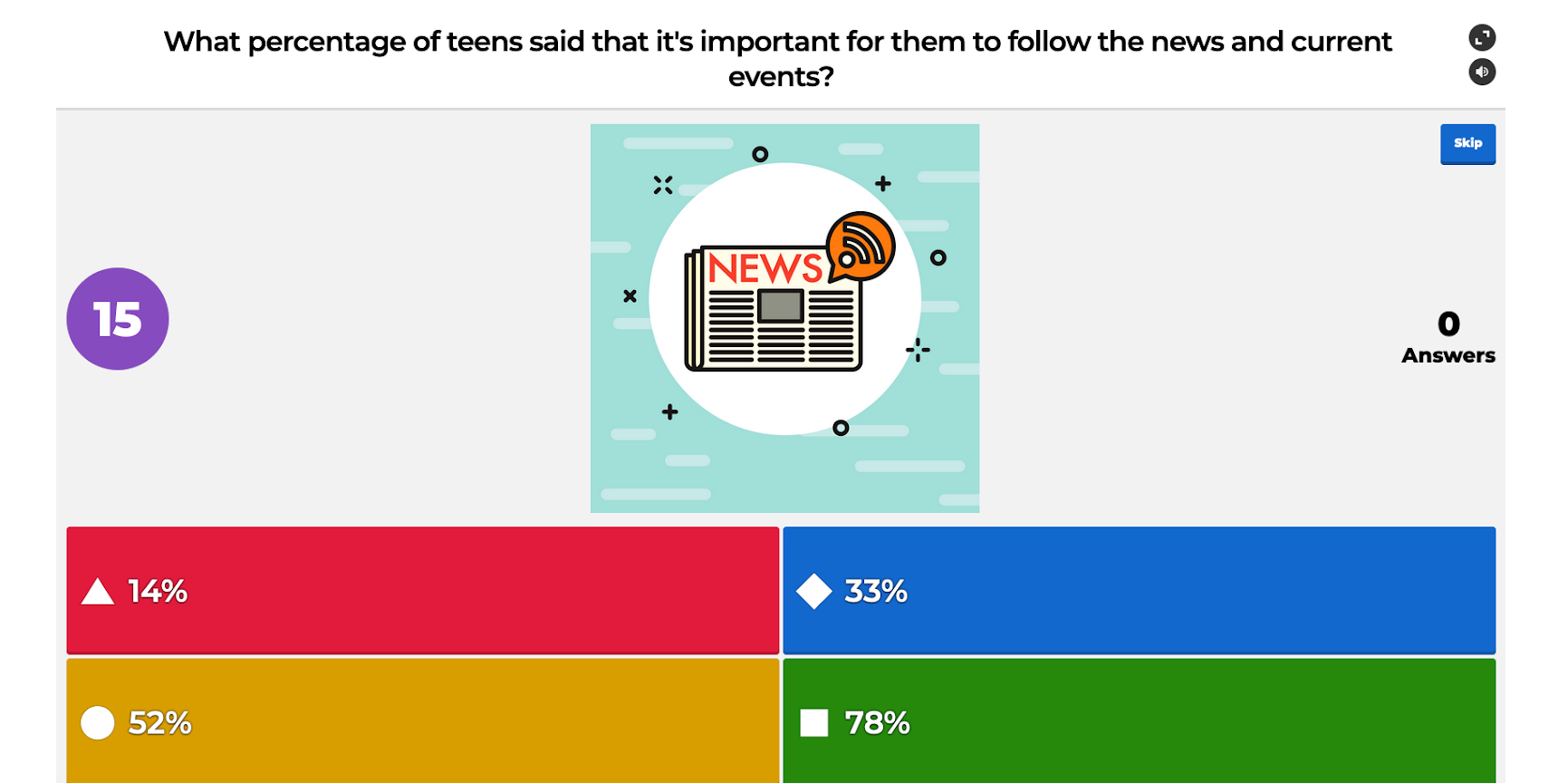
(Image Source: Stanford)
Kahoot has revolutionized the way teachers engage with students through its gamified quizzes. By turning quizzes into interactive games, Kahoot fosters a fun and competitive learning environment that significantly boosts student motivation and participation.
With a vast library of pre-made quizzes and the ability to create custom ones, you can easily integrate engaging activities into my lesson plans.
I also love the instant feedback and dynamic visuals that keep students attentive and excited about learning. So, Kahoot is perfect for educators who want to make learning enjoyable and interactive, ensuring that students retain information through a playful yet educational approach.
What You Will Like:
- It supports live quizzes and asynchronous assignments, providing flexibility in how and when assessments are delivered.
- Kahoot includes a large library of pre-made quizzes and resources, which can save educators time in quiz creation.
- It allows for multimedia integration, including images and videos, enhancing the visual appeal and interactivity of quizzes.
- The tool supports various question types, including puzzles and polls, allowing for diverse and creative assessments.
- It is accessible on multiple devices, including smartphones and tablets, making it convenient for students to participate from anywhere.
What You May Not Like:
- The free version has limited features and customization, which may not meet the needs of more advanced users.
- There can be issues with internet connectivity during live sessions, which can disrupt the quiz-taking experience.
Pricing: Starts at $19/host/month. Billed annually.
4. Flip
Best for Video Assessments

(Image Source: Cornell.edu)
Flip is an exceptional tool for conducting video assessments, offering students a platform to express their knowledge and creativity through video responses. This multimedia approach provides a deeper understanding of student comprehension and communication skills, which are often missed in traditional written tests.
The user-friendly interface makes it easy for students to record and share their videos, fostering a more engaging and personal assessment experience.
Flip is particularly beneficial for subjects like language arts, where verbal communication and presentation skills are crucial, and this is what I like the most about it. It’s an excellent choice for teachers who want to incorporate diverse assessment methods that capture a fuller picture of student abilities.
What You Will Like:
- It includes a variety of interactive tools, such as video comments and reactions, fostering a more interactive learning environment.
- Flip allows for collaborative learning with group video discussions, encouraging peer interaction and collaboration.
- It provides integration with popular LMSs, including Google Classroom and Microsoft Teams, ensuring it fits smoothly into existing educational workflows.
- The tool supports various media formats, including images, videos, and links, allowing for diverse and rich content in assessments.
- Flip offers privacy settings to control who can view and respond to videos, ensuring that student data is protected.
What You May Not Like:
- Video uploads can be time-consuming and require a stable internet connection, which may be a barrier for some students.
- The platform may not be suitable for text-based assessments, limiting its versatility for different types of evaluations.
Pricing: Custom pricing.
5. Mentimeter
Best for Live Quizzes
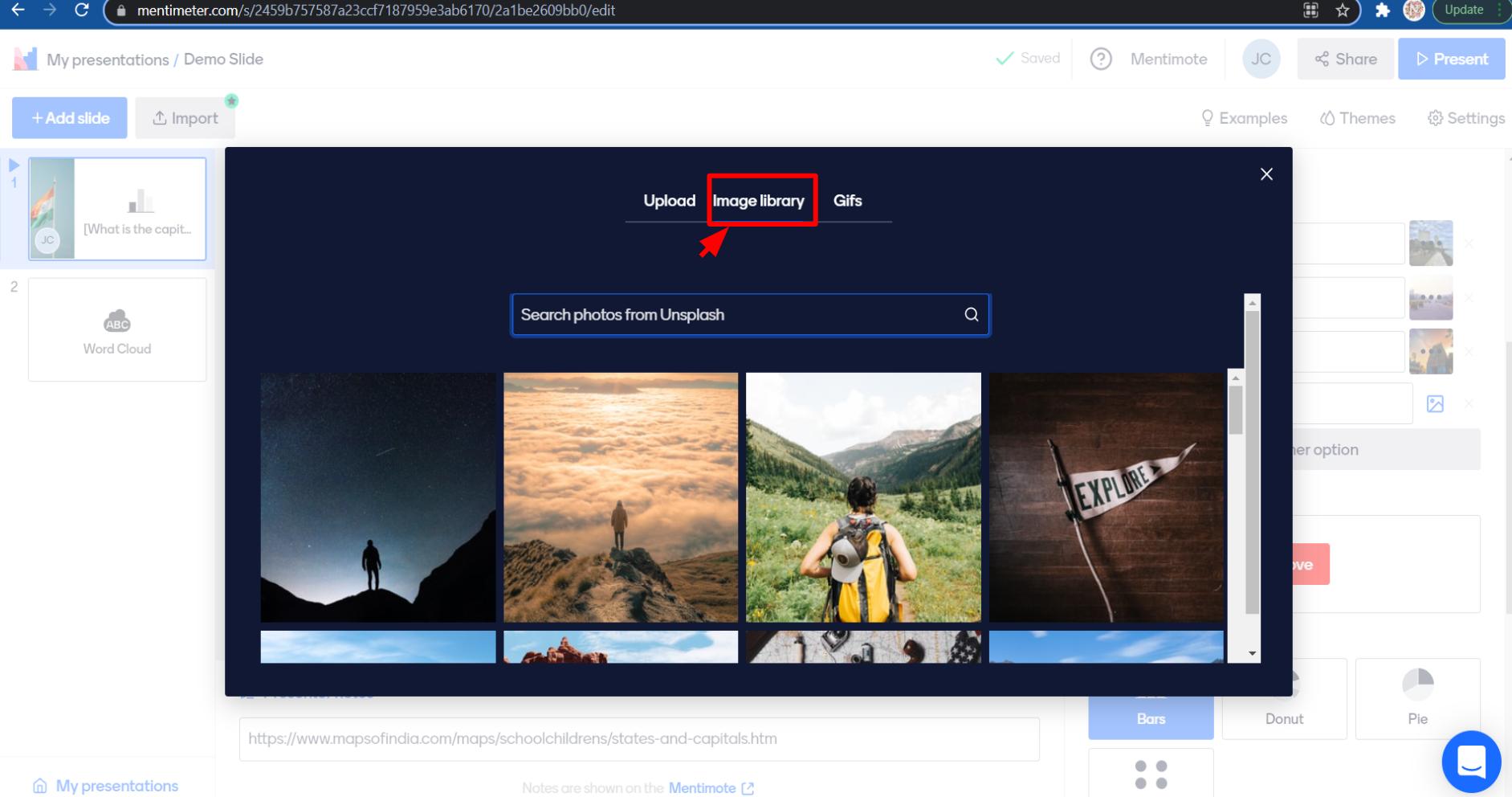
(Image Source: IPSR Solutions)
For live quizzes and immediate feedback, Mentimeter is my top recommendation. Its interactive features allow you to conduct real-time assessments, gauging student understanding instantly and adjusting your teaching accordingly.
The variety of question types and visualizations available in Mentimeter keep students engaged and actively participating. It is particularly useful in large classes where instant feedback can help identify common misunderstandings.
This tool is ideal for educators looking to create dynamic and interactive assessments that adapt to the classroom’s needs, promoting a more interactive and responsive learning environment.
What You Will Like:
- The platform provides instant feedback and data visualization, helping educators quickly gauge student understanding.
- Mentimeter supports multimedia integration, including images and videos, enhancing the visual appeal and interactivity of assessments.
- It offers seamless integration with presentation tools like PowerPoint and Google Slides, allowing for smooth transitions during presentations.
- The tool is accessible on multiple devices and does not require participants to create accounts, making it convenient for students to participate.
- Mentimeter provides detailed analytics and reporting features, helping educators analyze response data and improve their teaching strategies.
What You May Not Like:
- Advanced customization options are locked behind higher-priced plans, making them inaccessible to users on a tight budget.
- There can be a learning curve for new users to understand all features, which may require additional training and time investment.
Pricing: Starts at $11.99/presenter/month. Billed annually.
6. Socrative
Best for Formative Assessments
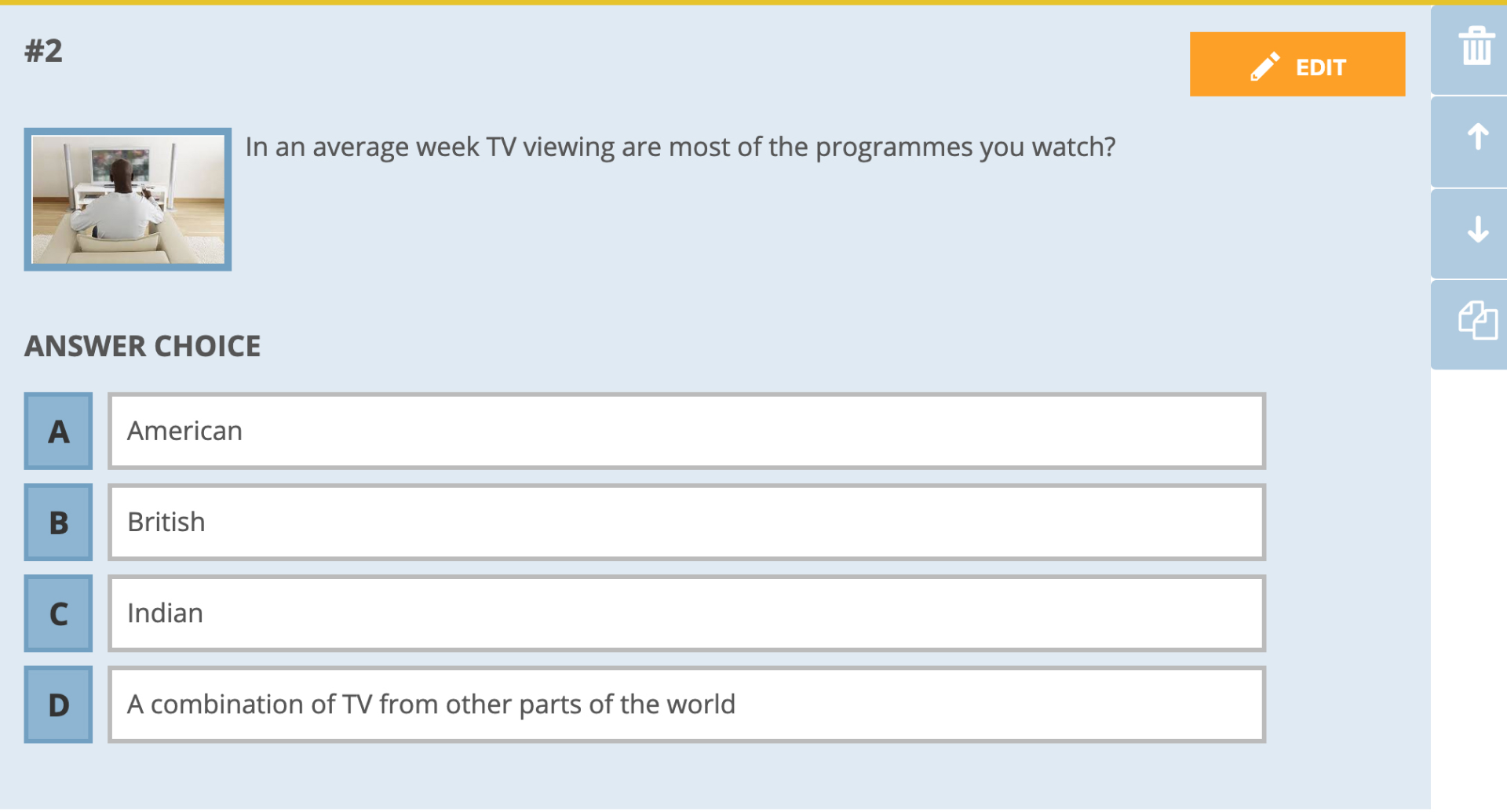
(Image Source: Socrative)
Socrative is an interesting tool for conducting formative assessments in classrooms. Its range of question types and real-time analytics provide valuable insights into student progress, helping teachers tailor the instruction to address individual learning needs.
The immediate feedback feature is particularly beneficial, allowing students to understand their mistakes and learn from them on the spot. Socrative’s ease of use and comprehensive reporting make it ideal for continuous assessment and improvement.
No doubt, this perfect for educators who prioritize formative assessments to guide their teaching strategies and enhance student learning outcomes.
What You Will Like:
- It supports a variety of question types, including multiple-choice, true/false, and short answer, providing flexibility in designing assessments.
- Socrative allows for anonymous responses, encouraging honest feedback from students.
- It includes a library of pre-made quizzes that can be customized, saving educators time in quiz creation.
- The tool supports multiple languages, making it accessible to a wider audience.
- Socrative offers integration with popular LMSs, including Google Classroom and Canvas, ensuring it fits smoothly into existing educational workflows.
What You May Not Like:
- Some users report occasional technical glitches and slow loading times, which can disrupt the quiz-taking experience.
- The platform may not be as engaging as game-based assessment tools, limiting its appeal to students.
Pricing: Starts at $9.99/seat/month. Billed annually.
7. Jotform
Best for Building Online Forms With Payment Gateways
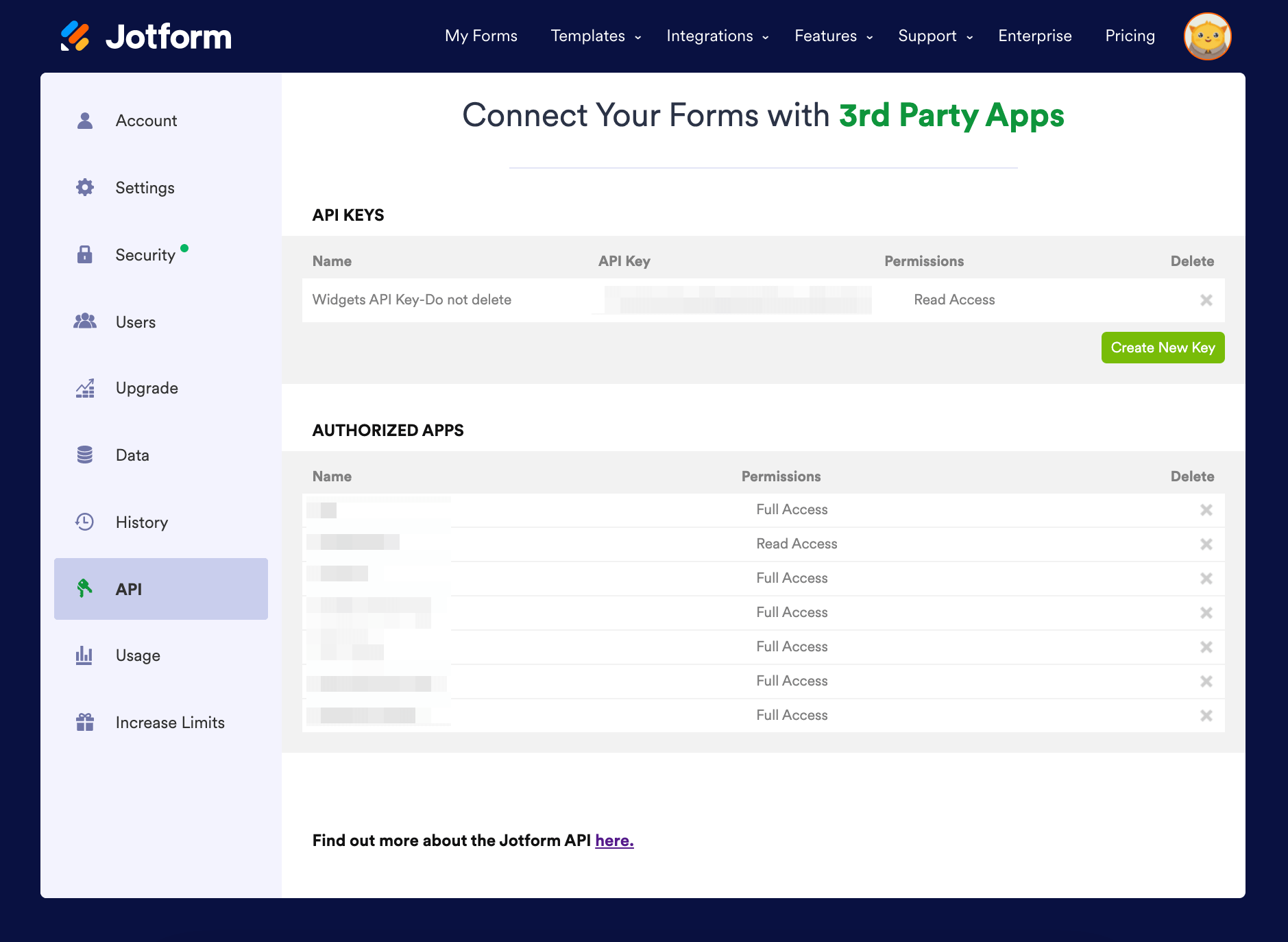
(Image Source: Jotform)
Jotform stands out for its versatility in creating online forms, especially those requiring payment integration. Its intuitive drag-and-drop interface and extensive template library simplify form creation.
I have used Jotform for assessments, managing event registrations, collecting course fees, and other administrative tasks. I like its built-in payment gateways, which ensure secure and seamless transactions and add a professional touch to the process.
So, if you need a multifunctional tool that can handle assessments and administrative functions, streamlining various aspects of educational management, this can be a good option.
What You Will Like:
- Jotform offers a wide range of customizable form templates, allowing educators to create assessments tailored to their needs.
- The platform provides real-time data collection and reporting, helping educators analyze response data and improve their teaching strategies.
- Jotform integrates with over 100 apps, including Google Drive and Dropbox, allowing for streamlined workflows and easy data sharing.
- It offers a user-friendly drag-and-drop form builder, making form creation simple and quick, even for users with minimal technical skills.
- The tool supports conditional logic, enabling dynamic form behavior based on user responses, and enhances the interactivity of assessments.
What You May Not Like:
- Advanced customization options require a subscription, making them inaccessible to users on a tight budget.
- The platform is not specifically designed for educational assessments, so it may lack some specialized features found in other tools.
Pricing: Starts at $34/month. Billed annually.
8. Quizlet
Best for Curriculum-Based Assessments
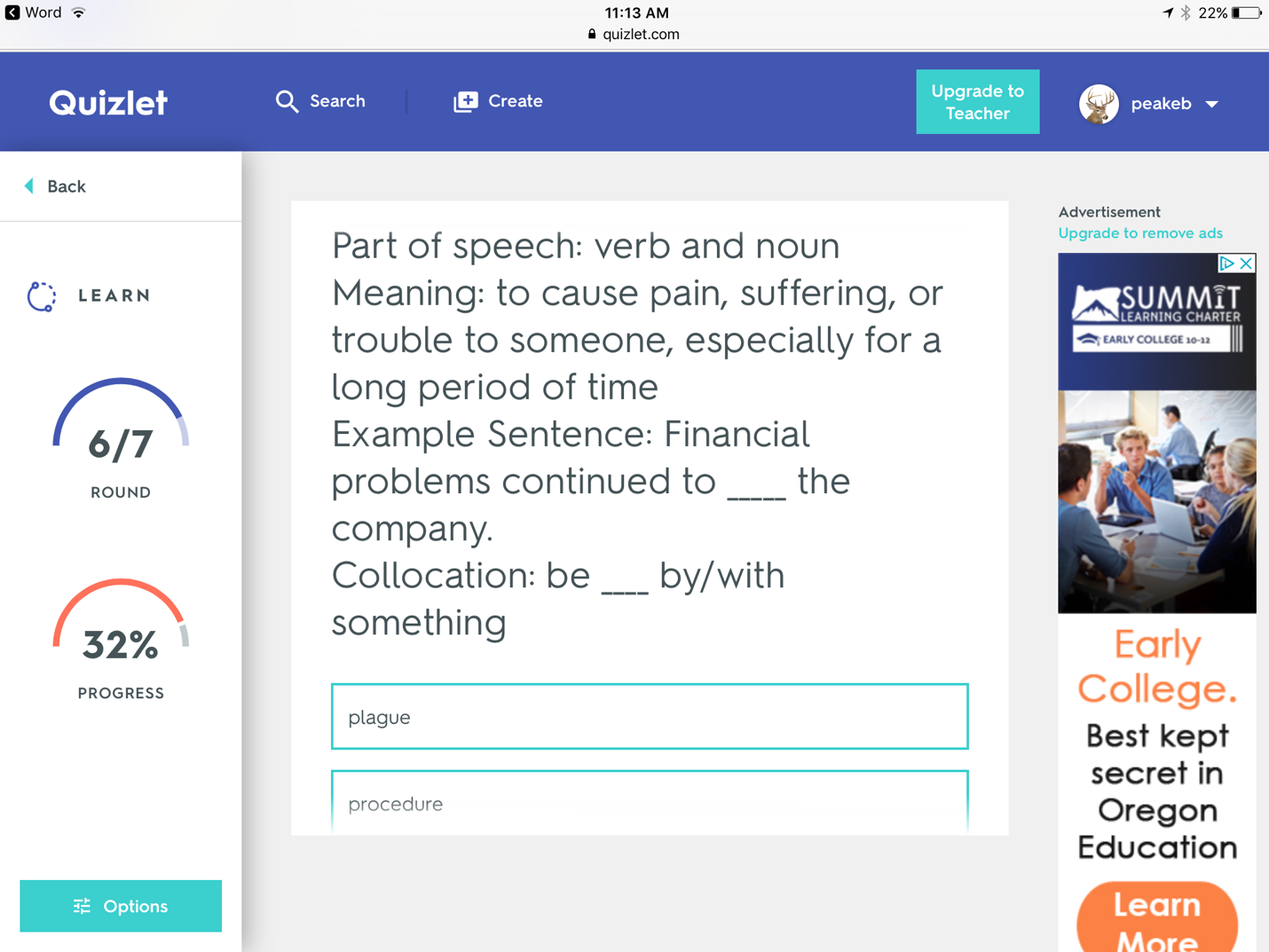
(Image Source: AES English)
Quizlet is one of the most intelligent evaluation tools for teaching, and it helps create curriculum-based assessments. Its flashcard system aids in memorization and recall, which is crucial for subjects requiring detailed knowledge retention.
You can create custom study sets and quizzes aligned with the curriculum, ensuring that assessments are targeted and effective. Quizlet’s interactive learning modes, such as matching games and test simulations, make studying engaging and enjoyable for students.
The platform also provides a large library of pre-made study sets that save educators time and can be handy in creating content for teaching.
What You Will Like:
- It supports multimedia integration, including images and audio, enhancing the visual and auditory appeal of study materials.
- Quizlet includes options for collaborative study and group work, encouraging peer interaction and cooperation.
- The tool offers real-time feedback and progress tracking, helping students understand their performance and identify areas for improvement.
- Quizlet is accessible on multiple devices, including smartphones and tablets, making it convenient for students to study from anywhere.
- It provides seamless integration with popular LMSs, ensuring it fits smoothly into existing educational workflows.
What You May Not Like:
- The free version has limited features and study modes, which may not meet the needs of more advanced users.
- The platform may not be suitable for in-depth assessments, limiting its use for more comprehensive evaluations.
Pricing: Starts at $1/month.
9. CommonLit
Best for Assessment Series
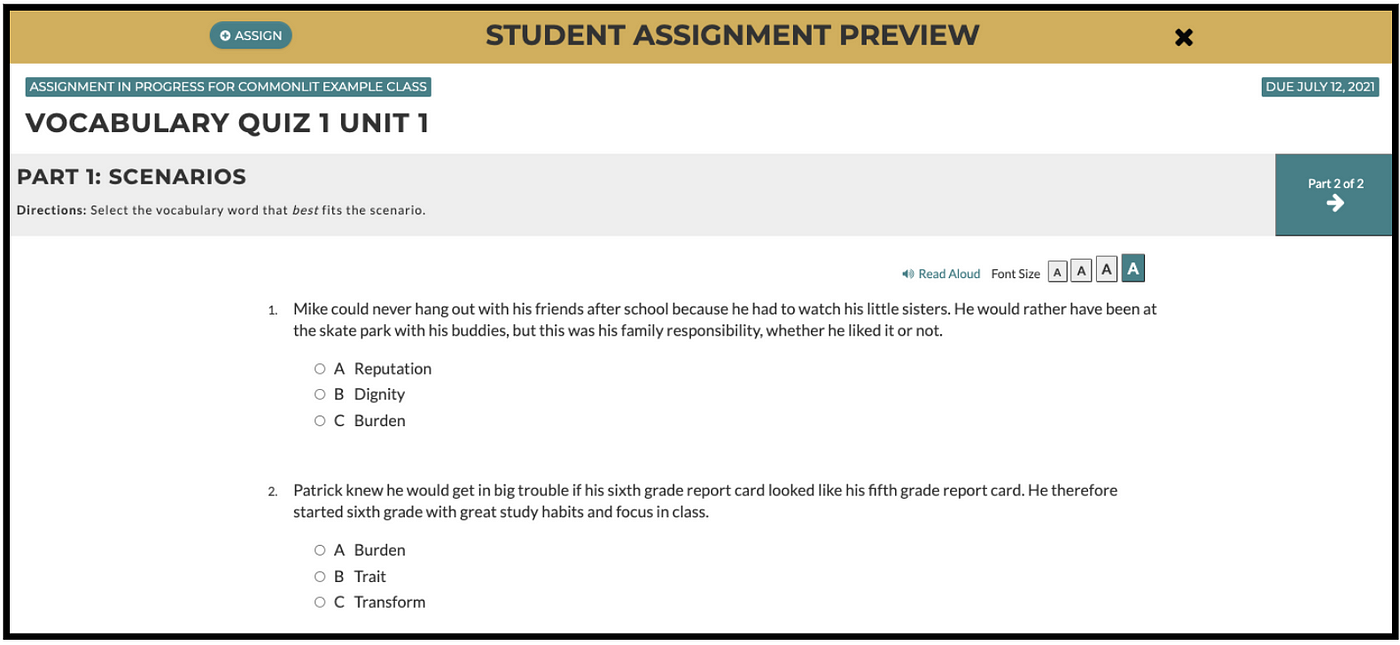
(Image Source: Medium)
CommonLit is a wonderful tool for conducting comprehensive assessment series, particularly in literacy and reading comprehension. It offers an extensive library of high-quality texts paired with thoughtful, standards-aligned questions.
I like its detailed analytics, which helps track student progress and identify areas for improvement, allowing for targeted instruction. Besides, its focus on critical thinking and textual analysis makes it an invaluable resource for developing students’ reading skills.
It even allows you to conduct in-depth assessments over time, providing a clear picture of student growth and areas needing attention.
What You Will Like:
- The platform supports differentiation with multiple reading levels for each passage, ensuring that all students can engage with the material.
- CommonLit includes options for guided reading and annotation, enhancing students’ reading comprehension and critical thinking skills.
- The tool provides integration with Google Classroom and other LMSs, ensuring it fits smoothly into existing educational workflows.
- It offers a variety of question types, including multiple-choice and short answer, providing flexibility in designing assessments.
- CommonLit is accessible on multiple devices, making it convenient for students to access reading materials from anywhere.
What You May Not Like:
- The platform may not be suitable for non-reading-based assessments, limiting its versatility for different types of evaluations.
- It experiences technical glitches when the internet connection is unstable.
Pricing: It has a school plan that starts at $2,500/year/school.
10. iSpring QuizMaker
Best for Integrating Quizzes With Learning Management Systems
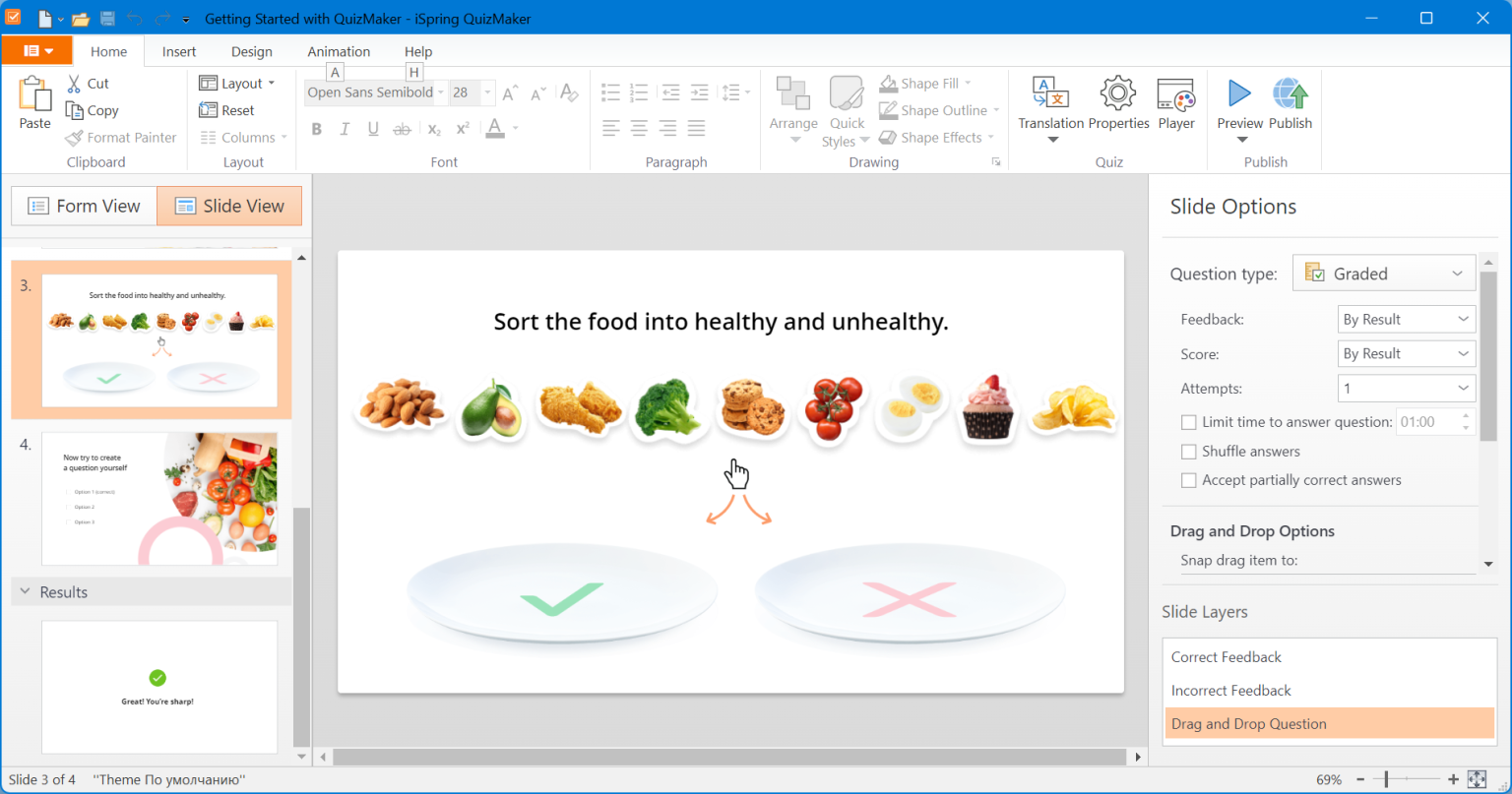
(Image Source: iSpring QuizMaker)
iSpring QuizMaker is my top choice for creating quizzes that integrate seamlessly with learning management systems (LMS). Its powerful features and SCORM compatibility ensure that quizzes can be tracked and reported within any LMS.
The extensive customization options allow you to design professional-quality assessments tailored to my curriculum. The tool’s user-friendly interface makes it easy to create detailed quizzes that provide comprehensive assessment data.
If you are looking for a reliable solution that works within your existing LMS, also ensuring smooth integration and efficient assessment management, this can be a good option for you.
What You Will Like:
- It has extensive customization options for quiz appearance, including themes, colors, and fonts.
- It offers comprehensive scoring options, including point-based and percentage-based scoring.
- You get smart, collaborative features that allow multiple users to work on quizzes simultaneously.
- The tool supports branching scenarios, enabling dynamic quiz paths based on student responses and enhancing the interactivity of assessments.
- iSpring QuizMaker provides real-time feedback and grading, helping students understand their performance immediately.
What You May Not Like:
- Although customizable, the available templates may not suit all design preferences or branding requirements.
- There is a learning curve for new users to fully utilize all features, which may require additional training and time investment.
Pricing: Starts at $470/author/year.
Also Read: 20 Best Formative Assessment Tools of 2024
FREE. All Features. FOREVER!
Try our Forever FREE account with all premium features!
Evaluation Criteria
The evaluation of products or tools chosen for this article follows an unbiased, systematic approach that ensures a fair, insightful, and well-rounded review. This method employs six key factors:
- User Reviews / Ratings: Direct experiences from users, including ratings and feedback from reputable sites, provide a ground-level perspective. This feedback is critical in understanding overall satisfaction and potential problems.
- Essential Features & Functionality: The value of a product is ascertained by its core features and overall functionality. Through an in-depth exploration of these aspects, the practical usefulness and effectiveness of the tools are carefully evaluated.
- Ease of Use: The user-friendliness of a product or service is assessed, focusing on the design, interface, and navigation. This ensures a positive experience for users of all levels of expertise.
- Customer Support: The quality of customer support is examined, taking into account its efficiency and how well it supports users in different phases – setting up, addressing concerns, and resolving operational issues.
- Value for Money: Value for money is evaluated by comparing the quality, performance, and features. The goal is to help the reader understand whether they would be getting their money’s worth.
- Personal Experience / Experts’ Opinions: This part of the evaluation criteria draws insightful observations from the personal experience of the writer and the opinions of industry experts.
Ensure Smarter Teaching With Assessment Tools & Software
Assessment tools play a pivotal role in teaching by enhancing learning outcomes and providing educators with insights into student progress or areas needing improvement. These tools also facilitate personalized instruction, promote active learning, and help maintain educational standards. Among the myriad options available, my favorite is ProProfs Quiz Maker, which stands out for its user-friendly interface, customizable quiz templates, and detailed reporting features. I particularly like its AI quiz tool, automated grading, a vast question bank, and seamless integration with other educational platforms, making it a great tool for effective teaching.
 Tips
Tips
We’d love to hear your tips & suggestions on this article!
Write Here
FREE. All Features. FOREVER!
Try our Forever FREE account with all premium features!
 We'd love your feedback!
We'd love your feedback!
What did you like & how can we make it even better?
 Thanks for your feedback!
Thanks for your feedback!
 Ask Your Question
Ask Your Question
Have a question? Get expert help to make your decision easier.
 Thanks for your feedback!
Thanks for your feedback!
